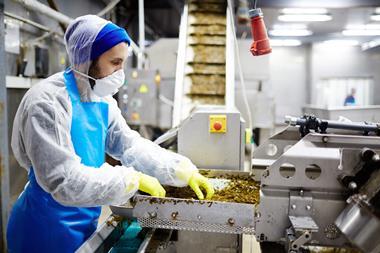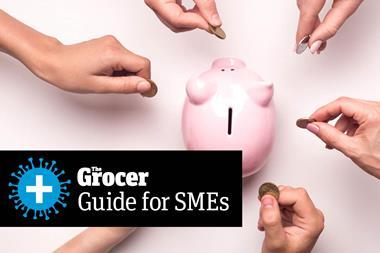![Guide to SMEs_Article image_long[3]](https://dmrqkbkq8el9i.cloudfront.net/Pictures/480xany/2/3/6/183236_guidetosmes_articleimage_long3_307021.jpg)
This is the first in our free series, Guide for SMEs which aims to provide practical, actionable advice for small food and drink brands impacted by the coronavirus crisis
The government has announced a broad package of measures to support UK businesses through the coronavirus crisis. So what financial help can food and drink SMEs get? And what do they need to do?
Chancellor Rushi Sunak has unveiled a number of schemes and services to help SMEs battle their way through the disruption caused by the coronavirus crisis.
They range from a job retention scheme allowing businesses to ‘furlough’ employees until the crisis is over, to delayed tax payments, sick pay relief, business grants and loans.
To find out exactly what’s on offer, who is eligible and how to apply, just follow the links below:
- The Coronavirus Job Retention Scheme
- Deferring VAT payments
- Deferring Self-Assessment payments on account
- Time to Pay service
- Statutory Sick Pay relief package for small and medium sized businesses
- Small Business Grant Scheme
- Coronavirus Business Interruption Loan Scheme
- Protection from eviction for commercial tenants
- Future Fund
- Bounce Back Loan Scheme
The coronavirus job retention scheme
What is it?
This temporary scheme is to support employers whose operations have been “severely affected by coronavirus”.
It allows employees to furlough staff who can’t do their jobs during the crisis – which essentially means keeping them on the payroll even though they aren’t working.
Businesses can claim 80% of their employees’ wages back from the government, up to a maximum of £2,500 per person, per month before tax.
The scheme is open from 1 March 2020 until June, and businesses can claim at any time during that period. It may be extended further if necessary.
Who can apply?
The scheme is open to all UK businesses that created and started a PAYE payroll scheme by 28 February 2020.
Employees can be on any type of contact – including full-time, part-time, agency, flexible or zero-hour contracts.
However, you can only claim for furloughed employees that were on your payroll on or before 28 February 2020 – so you wouldn’t be able to claim for a new member of staff who joined the business after that date, for example.
Employees must be furloughed for a minimum period of three consecutive weeks. They can be furloughed multiple times, but each separate instance must be for a minimum period of three consecutive weeks.
When considering who to offer furlough to, remember that equality and discrimination laws will apply in the usual way.
What is the process?
1. Firstly, you should discuss any changes with your staff, and then confirm in writing to employees that have been furloughed (keep a record of that communication for five years).
2. Next, gather the information you need to apply:
- Your ePAYE reference number
- The number of employees being furloughed
- The claim period (start and end date)
- Amount claimed (per the minimum length of furloughing of three consecutive weeks)
- Your bank account number and sort code
- Your contact name
- Your phone number.
3. Calculate the amount you are claiming – bearing in mind HMRC has the right to audit all aspects of your claim.
4. Make a claim through the government’s online service. This is not available yet but should be functional by the end of April 2020, the government claims.
Keep an eye on the government’s online portal – which also has more detailed information on the scheme. Any claims can be backdated to 1 March 2020 where employees have already been furloughed.
5. Once HMRC has checked your claim it will be paid by BACS into your UK bank account. You must then pay the employee the entire grant you receive for their gross pay.
What happens when the scheme ends?
You’ll have to make a decision – depending on your current circumstances – as to whether employees can return to their normal duties.
If not, it may be necessary to consider redundancy – or transferring them to a new or different role.
Deferring VAT payments
What does it mean?
The government is allowing businesses to defer value-added tax (VAT) payments for three months.
In other words, if you have a VAT payment due between 20 March 2020 and 30 June 2020, you have the option to defer the payment until a later date. However, you will still need to submit your VAT returns to HMRC on time.
Who is eligible?
Any UK VAT-registered business can choose to either defer their payments or continue paying VAT as normal. The scheme doesn’t cover payments for VAT MOSS or import VAT.
What’s the process?
You don’t need to tell HMRC that you are deferring your VAT payment. If you normally pay by direct debit, simply contact your bank to cancel the direct debit.
What happens when it ends?
If you choose to defer your VAT payment because of coronavirus, you must pay the VAT due by 31 March 2021. The government has yet to confirm how to repay the VAT you’ve deferred, so keep an eye on its online portal for the latest advice.
VAT payments due from the end of the deferral period will have to be paid as normal.
Deferring self-assessment payments on account
What is it?
If you were due to pay a self-assessment payment on account by 31 July 2020 but the impact of coronavirus is making that difficult, you can defer payment until January 2021.
Who is eligible?
You are eligible if you were due to pay your second self-assessment payment on account on 31 July.
What’s the process?
This is an automatic scheme, so there is no need to apply. Simply make the payment by January 2021.
Time to Pay service
What is it?
This is additional government support for businesses struggling to pay outstanding taxes as a result of the coronavirus outbreak.
Who is eligible?
Any business in financial distress due to coronavirus that pays taxes to the UK government and has outstanding tax liabilities can apply. However, decisions will be made on a case-by-case basis depending on your individual circumstances and liabilities.
What’s the process?
If you’ve already missed a payment, or you are worried about your next payment, just call HMRC’s dedicated helpline on 0800 024 1222.
Statutory sick pay relief package for small and medium-sized businesses
What is it?
Under this scheme, SMEs can reclaim their employees’ coronavirus-related statutory sick pay.
Who is eligible?
Businesses with fewer than 250 employees with a payroll scheme that was created and started before 28 February 2020.
The repayment will cover the current rate of SSP for up to two weeks starting from the first day of sickness for any employees that either have coronavirus or cannot work because they are self-isolating at home. They don’t need to give you a doctor’s note to make a claim.
The scheme covers part-time and full-time staff as well as those on flexible or zero-hour contracts and agency staff.
What’s the process?
First, keep a record of all statutory sick payments you want to claim from HMRC, including:
- The reason why an employee could not work
- Details of each sickness period when an employee could not work including start and end dates
- The National Insurance numbers of all employees who you have paid SSP to.
You will have to keep these records for at least three years following your claim.
To make a claim, you’ll need to use the government’s SSP online service. However, it’s not available yet, so keep an eye on HMRC’s guidance for more details.
Small business grant scheme
What is it?
A one-off grant of £10,000 for small businesses to help meet ongoing costs.
Who is eligible?
Any business based in England that occupies a property and was receiving small business rates relief or rural rates relief as of 11 March.
What’s the process?
Contact your relevant local authority. If you are eligible, they should contact you – but some local authorities have decided to operate an online application process.
Coronavirus Business Interruption Loan
What is it?
This temporary loan scheme is designed to give SMEs access to loans, overdrafts, invoice finance and asset finance of up to £5m for up to six years.
The government will make a business interruption payment to cover 12 months of interest payments and any lender-levied fees, so SMEs benefit from no upfront costs and lower initial repayments.
Who is eligible?
UK-based businesses with an annual turnover of no more than £45m. To qualify, you must also have a borrowing proposal the lender would consider viable were it not for the current pandemic and be able to self-certify that you have been adversely impacted by coronavirus.
What’s the process?
1. Firstly, find a lender. More than 40 accredited lenders across the UK are involved in the scheme and you can view them here.
2. Secondly, approach the lender. You should do this yourself, ideally via the lender’s website. Keep in mind there is likely to be high demand for these facilities so phone lines will be busy and branches may not be able to handle queries in person.
To apply for the business loan, you will need the following information:
- The amount you would like to borrow
- What the money is for
- The period over which you will make the repayments.
You will also need to provide supporting documents to prove you can afford to repay the loan. This is likely to include the following, although it might vary from lender to lender.
- Management accounts
- Cashflow forecast
- Business plan
- Historic accounts
- Details of assets.
3. The lender will then make a decision. If they turn you down, you can approach other lenders within the scheme.
Protection from eviction for commercial tenants
What is it?
Under this scheme, commercial tenants who cannot pay their rent because of coronavirus will be protected from eviction.
It’s not a rental holiday – commercial tenants will still be liable for the rent – however, they will be protected from eviction if they miss a payment up until 30 June. The government will extend this period if needed.
Who is eligible?
All commercial tenants in England, Wales and Northern Ireland
What’s the process?
No action is required – the change will come into force when the Coronavirus Bill receives Royal Assent
Future Fund
What is it?
A £500m investment fund for high-growth companies impacted by the coronavirus outbreak, made up of funding from both the government and the private sector.
Launching in May and delivered in partnership with the British Business Bank, the fund will provide UK-based companies with convertible loans of between £125k and £5m from the government, subject to at least equal match funding from private investors.
The loans will then convert into equity - at a 20% discount - on the company’s next funding round or at the end of the loan if it hasn’t been repaid.
Who is eligible?
The scheme is open to “innovative” companies in sectors ranging from tech to life sciences, to ensure they can continue to drive growth.
It is also a suitable option for businesses that rely on equity investment and cannot access the Coronavirus Business Interruption Loan Scheme.
Business registered in the UK must have raised at least £250k in equity investment from third party investors within the last five years to be elegible.
If the business is part of a corporate group, only the ultimate parent company can receive the loan.
What’s the process?
As the scheme has not yet launched, more details will be published by the government in “due course”.
What is clear at the moment is that a business needs to be able to secure private investment to qualify.
Bounce Back Loan Scheme
What is is?
The government’s latest scheme providing small businesses with micro-loans of between £2k and £50k - up to 25% of turnover - with the cash made available within days.
The loans will be 100% government-backed, so lenders will not have to take on any risk in case of default. Interest is free for the first 12 months.
During the first year, there will also not be any repayments due.
Who is eligible?
You can apply for a Bounce Back loan if your business is based in the UK, has been negatively affected by coronavirus and was not an “undertaking in difficulty” on 31 December 2019.
You cannot apply if you have already received funding under the Coronavirus Business Interruption Loan Scheme.
What’s the process?
The scheme is due to launch on 4 May and the government has vowed it will be easy and straight forward to apply for the loans, through a short, standardised online application to one of the accredited lenders. More details will be released in “due course”.




















No comments yet